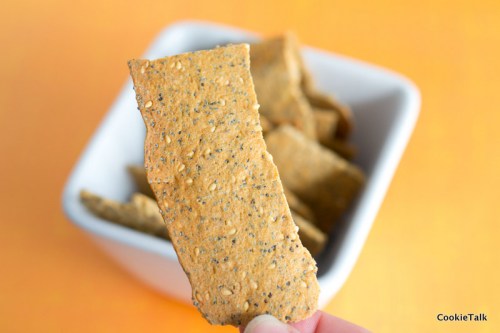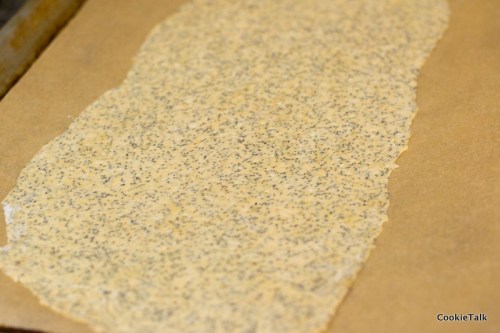Our Daring Bakers Host for December 2011 was Jessica of My Recipe Project and she showed us how fun it is to create sourdough bread in our own kitchens! She provided us with sourdough recipes from Bread Matters by Andrew Whitley as well as delicious recipes to use our sourdough bread in from Tonia George’s Things on Toast and Canteen’s Great British Food!

I’m not new to baking bread. In fact, we haven’t bought bread in about two years because I’ve been making our bread exclusively. I know, I know, I hardly ever post bread on here. That’s because making bread is second nature to me now. It’s part of my daily routine. But my New Year’s Resolution is to blog all my favorite bread recipes in January and February. And I’ll give you plenty of tips so that you too can start making bread on a regular basis.
This recipe, however, is messy, not easy to work with, and terrible to shape. All that is fine for an experienced bread maker, but may be frustrating for a new bread maker. It was frustrating for me! It does taste good, but not like sourdough that you are probably accustomed to.
 The good thing about this bread is the crumb structure. You’ll notice how light and airy it is. That’s because this is an extremely wet dough! Almost as wet as ciabatta, which is also very light and airy.
The good thing about this bread is the crumb structure. You’ll notice how light and airy it is. That’s because this is an extremely wet dough! Almost as wet as ciabatta, which is also very light and airy.
I did not make this bread by hand, but used the dough hook instead. It’s much easier to make bread that way and I especially recommend it for this dough. It will make your life easier!
This is a minimum of a five day process, though very little actual hands on. My starter took much longer since it is quite cool in my house right now. I gave my starter almost two weeks to get going, at first feeding daily (and quite appalled at the initial smell, so much so that I almost threw it out), then every couple of days as it started to grow and bubble. It won’t smell tangy since it is a new starter, but it should bubble and start to smell yeasty.
Read through the entire procedure before starting. And if you are new to bread making, don’t be afraid to try it. It is challenging, but pretty hard to screw up. The biggest rule is to use quality flour. Using good quality flour is always important, but it makes the biggest difference with bread. I once used cheap flour for pizza dough and the recipe completely failed. Switched to a good bread flour and I had perfect pizza. So skip store brands and go for unbleached flour and good wheat flour.
Country Wheat Bread
Day 1
- 4.5 TB (40 gr/ 1.5 oz) whole wheat flour
- 3 TB water
In a medium sized storage container, mix the flour and water into a paste. Cover and set aside in a warm place.
Day 2
- 4.5 TB (40 gr/ 1.5 oz) whole wheat flour
- 3 TB water
Mix flour and water into previous days mixture. Cover and return to warm place.
Day 3
- 4.5 TB (40 gr/1.5 oz) whole wheat flour
- 4 tsp water
Mix flour and water into previous days mixture. Cover and return to warm place.
Day 4
- 3/4 cup plus 1½ tablespoons (120 gm/4.25 oz) unbleached all-purpose flour
- 1/2 cup less 4 teaspoons (100 ml) water
Mix flour and water into mixture. At this point it will hopefully be bubbling and starting to smell pleasant. Mine was not at this point and I almost threw it out because I did not like the smell. I continued this step for several more days and it was bubbly and smelling yeasty, so I think it was the wheat flour that gave a different smell than what I’m used to. I’ve never used a wheat starter before. After about 3 days of feeding with white flour, I started feeding every other day and reduced to 1/3 cup flour and 1/4 cup water. I didn’t actually use the starter until day 13, although it was ready a few days before that. I just didn’t have time when it was ready. I kept it at room temperature and continued to feed it.
Day 5 (or whichever day it ends up being for you)
- 1 cup less 1 tablespoon (160 gr/5 ⅔ oz) starter
- 6 tablespoons less 1 teaspoon (50 gr/1¾ oz) whole wheat flour
- 1 cup plus 2 teaspoons (150 gr/5 ⅓ oz) unbleached bread flour (AP will work too, but bread would be better)
- 1/2 cup (120 ml) water
Mix all together with a wooden spoon or this nifty contraption. It will be messy and not form a smooth ball. I mixed mine in the mixer bowl since I knew I’d be using it later. Loosely cover with plastic wrap.

Let rest in a warm place (try the oven with the oven light on. Just don’t forget it is in oven!) for about four hours. Then it will look like this:
 Then add the remaining ingredients:
Then add the remaining ingredients:
- 3/4 cup less 1 teaspoon (100 gr/3 ½ oz) stoneground breadmaking whole-wheat or graham flour, plus more for dusting
- 2 cups plus 2 tablespoons (300gr/10 ½ oz) unbleached bread flour or AP flour
- 2¼ teaspoons sea salt (use less if you are using basic table salt)
- 1 ¼ cups (300 ml) water
1. Using the dough hook on your mixer, knead for about 10 minutes or until mixture is smooth and pulls away from the bowl slightly. It will still be very sticky though. Alternately, mix with wooden spoon and knead lightly. Let rest for one hour. Avoid adding additional flour if you knead by hand. Just dampen them with water.
2. After one hour, perform a set of stretch and folds. Just stretch each of the four sides over onto itself and form a smooth ball (it will be difficult since it is a sticky dough. Dampen your hands with a little bit of water to make it easier). If you have a bannetone, spray it with non stick spray and flour very heavily, all the way to the top. Or place a thin towel or bannetone liner and flour heavily. If you do not have a bannetone, place a thin towel, heavily floured, into a shallow bowl. Place the dough into the bowl, seam side up (if you have a seam, might be too sticky). Lightly flour the top and cover loosely with a thin towel.
3. Let rest another 3 to 5 hours. It will double in size. Once it is almost ready, preheat the oven to 425F (remember to take your dough out first if you are proofing it in the oven!). Take the dough and flip it onto a sheet pan lined with parchment or silpat. The easiest way to do this is to put the sheet pan on top of the bowl and flip it over. It may stick a bit. If so, just use a knife to gently cut away the parts that are sticky. Try not to pull the dough too much at this point.
4. Using a sharp knife, lightly score (cut) the bread in about three spots. Just use a quick movement to cut the dough about 1/2 inch. This will allow the bread to bake evenly and will make it look pretty. However, your dough may be too sticky and this will not work. Don’t fret if it doesn’t.
5. Place dough in oven and lower temperature to 400F. Bake for about 40 minutes or until bread is golden. Temperature in the center should be no less than 190F.
6. Let cool and enjoy!
Some tips on using your bread: I like to enjoy bread with either butter or dipped in olive oil and a glass of wine to wash it all down. But this bread makes a great sandwich. I had some leftover prime rib which I sliced thin, warmed up in a saute pan, sprinkled some cheese on it, and placed between two slices for a very tasty lunch. It would make a great panini, grilled cheese (for a grown up version try adding some sauteed mushrooms and onions), and crostini.
Maintaining your starter: If you won’t be using your starter for a week or more, place in the refrigerator and take it out to feed once a week. At least every other time you feed it, discard some of the old starter before stirring in fresh flour.
Cleaning your kitchen: In this day and age we are obsessed with anti-bacterial everything. This kills all the good bacteria and can actually hurt your starter when it meets your kitchen counter. And, those chemicals can get into your bread as well. I clean my kitchen with vinegar, baking soda, and mild soap. That’s it. No ultra-kill-everything-die-germs-die cleaner, just the basics. It’s cheaper and better for you. Vinegar still kills all the bad bacteria while leaving no residue behind. At the very least, refrain from using the harsh chemicals where your bread will be.

 On a side note, I do not like taking pictures of crackers. I don’t think they are photogenic. Good thing they are tasty.
On a side note, I do not like taking pictures of crackers. I don’t think they are photogenic. Good thing they are tasty.






 This cake would be easy to personalize to meet your taste buds. I didn’t find the nutmeg overwhelming but I do love nutmeg. I also added a pinch of cinnamon. Nutmeg and cinnamon are just meant to be together, in my humble opinion. But if they aren’t your favorite spices, just add whatever suits you. This cake has a beautiful caramel taste. The edges get a little more done than the center but that was actually my favorite part. A little bit chewier and caramel-y.
This cake would be easy to personalize to meet your taste buds. I didn’t find the nutmeg overwhelming but I do love nutmeg. I also added a pinch of cinnamon. Nutmeg and cinnamon are just meant to be together, in my humble opinion. But if they aren’t your favorite spices, just add whatever suits you. This cake has a beautiful caramel taste. The edges get a little more done than the center but that was actually my favorite part. A little bit chewier and caramel-y.




























